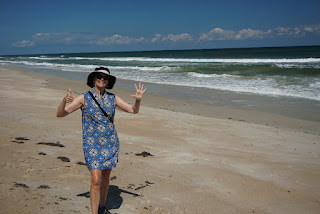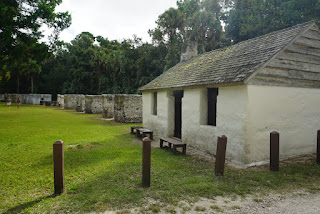October 13, 2021
On our ferry out to Cumberland Island yesterday, Aimee and I kept an eye out for a nuclear submarine cruising out of Kings Bay Naval Submarine Base here in St Marys, GA. We were unsuccessful so this morning we drove to the base gate. There I was able to see a nuclear-powered missile submarine surface from the depths!
Afterwards we crossed the St Marys River into Florida and back to Amelia Island where we caught Florida A1A. We took this ocean road south across the Nassau Sound to Big Talbot Island State Park stopping at Boneyard Beach. While Aimee beachcombed for shark teeth again, I took some photos. This shoreline is littered with the bleached ‘skeletons’ of Oak trees that are being eroded off the cliff.
We then continued south to Fort George Island Cultural State Park stopping at the Ribault Club. This repurposed resort has some exhibits on the history of the island starting with its first inhabitants, the Timucuan Indians. There are lots of shell middens (garbage dumps) from their extensive feasting on clams, oysters, and crabs.
Nearby we stopped at the Kingsley Plantation, part of the Timucuan Ecological and Historic Preserve. This national park protects the salt marsh wetlands habitat in the greater Jacksonville area that was the home of the Timucuan. It also interprets the slave plantation heritage that is exemplified here at Kingsley. This estate thrived on growing Sea Island Cotton. The preserved slave colony, a semi-circle of 25 tabby-cement cabins, is the most interesting part. The life history of the owner’s slave-wife was also fascinating.
Afterwards, we made our way around and across the wide St Johns River to Fort Caroline National Memorial. This park commemorates the first French attempt to settle in the USA territory. It occurred here at the mouth of the St Johns River in Jacksonville. Unfortunately Florida lay uncomfortably close to the shipping route of the Spanish galleons following the Gulf Stream home. To safeguard their treasure cargoes, Spain established the town of St Augustine, FL. From that base, they attacked the French colony slaughtering all the colonists.
After looking at the exhibits in the Visitor Center we walked out to the recreated French fort on the shoreline. We then drove down the block to see the Ribault Monument. This is a replica of the boundary post the French explorer planted to mark the border of their new conquests.
Leaving Jacksonville, we continued south to St Augustine. Just north of the historic town center we visited Fort Mose Historic State Park. Needing to strengthen their defense against British assaults, the Spanish encouraged runaway slaves to seek refuge here. They settled them here at Mose in exchange for conversion to Catholicism and military service when needed. We walked out to view the site of the fortified settlement. It now lies under a salt marsh.
We then checked into our St Augustine accommodations and walked to the Historic District. We checked out some exhibits in the Visitor Center and then strolled through the old city gate and down St George Street. This narrow street is filled with historic buildings that now house shops and restaurants and tourist attractions. We stop and watch the action from a second floor outdoor cafe while re-hydrating.
For dinner we have a burger at the Prohibition Kitchen. The backside of the menu has information about the 18th and 21st Amendments enacting Prohibition and its subsequent repeal. It is non-stop history today. Even at dinner!
















































